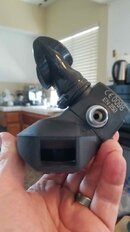Background - my sons D350 was sent out for service and adjusted to the lowest factory spec (1.1" - which due to liability etc. is as far as they probably want to go - I get it), but it seemed like some of the performance was missing. On another thread I mentioned this, and it was noted that the unit could be further tuned.
I took rsingler's advice on another thread - Take a pin wrench and unscrew the top cap. Use a small screwdriver to unscrew the adjustment disc in the center of the hole 1/24 turn (2.5 minutes on a clock). Put the disc back on and test on a tank, with the sink test of cracking effort Regulator Inspection and Checklist (Rev-8) Repeat until your stiffness is gone and cracking effort is 1".
So with that in mind, below was the starting point.. At this point the unit could be mouthpiece up, and submerged to past the tie-wrap on the mouth piece.

I went ahead and tried the 1/24th turn, with little effect. I continued this 4-5 times, and finally for grins, just went what appears to be 110-120 degrees from start, which I figured was enough for now. At present the unit begins to free-flow when the S is exposed, and has better breathing effort.


From the above, have I taken it too far?
Going forward I bought another D350 on eBay (with a Mk10 Plus 1st stage) that I plan on taking apart to learn more about this particular setup, and rebuild, so my son has a spare to fall back on - though with price of rebuild kits for these, I might also just send it in, to get base lined, and then tune it once it comes back.
I took rsingler's advice on another thread - Take a pin wrench and unscrew the top cap. Use a small screwdriver to unscrew the adjustment disc in the center of the hole 1/24 turn (2.5 minutes on a clock). Put the disc back on and test on a tank, with the sink test of cracking effort Regulator Inspection and Checklist (Rev-8) Repeat until your stiffness is gone and cracking effort is 1".
So with that in mind, below was the starting point.. At this point the unit could be mouthpiece up, and submerged to past the tie-wrap on the mouth piece.
I went ahead and tried the 1/24th turn, with little effect. I continued this 4-5 times, and finally for grins, just went what appears to be 110-120 degrees from start, which I figured was enough for now. At present the unit begins to free-flow when the S is exposed, and has better breathing effort.
From the above, have I taken it too far?
Going forward I bought another D350 on eBay (with a Mk10 Plus 1st stage) that I plan on taking apart to learn more about this particular setup, and rebuild, so my son has a spare to fall back on - though with price of rebuild kits for these, I might also just send it in, to get base lined, and then tune it once it comes back.





